Corporations Act 2001 Contraventions: Medco Ltd. Case Analysis Report
VerifiedAdded on 2019/09/23
|8
|3476
|146
Report
AI Summary
The report provides a critical analysis of the Medco Ltd. case, focusing on potential contraventions of the Corporations Act 2001. The scenario involves a company seeking government funding under the National Innovation and Science Agenda (NISA) based on research on lanolin. However, the research was conducted by another company owned by a Medco Ltd. director. The report examines the directors' actions, including a premature announcement to the Australian Stock Exchange (ASX), share purchases, and subsequent share price drops, leading to investor losses. The analysis highlights potential violations of Section 1041A (market manipulation) and Section 1041E (false or misleading statements) of the Corporations Act 2001. It discusses the implications of civil penalties, director liabilities, and the importance of accurate information in financial markets, referencing a similar case involving market manipulation. The report concludes with a discussion of potential penalties and civil actions for damages resulting from the directors' actions.
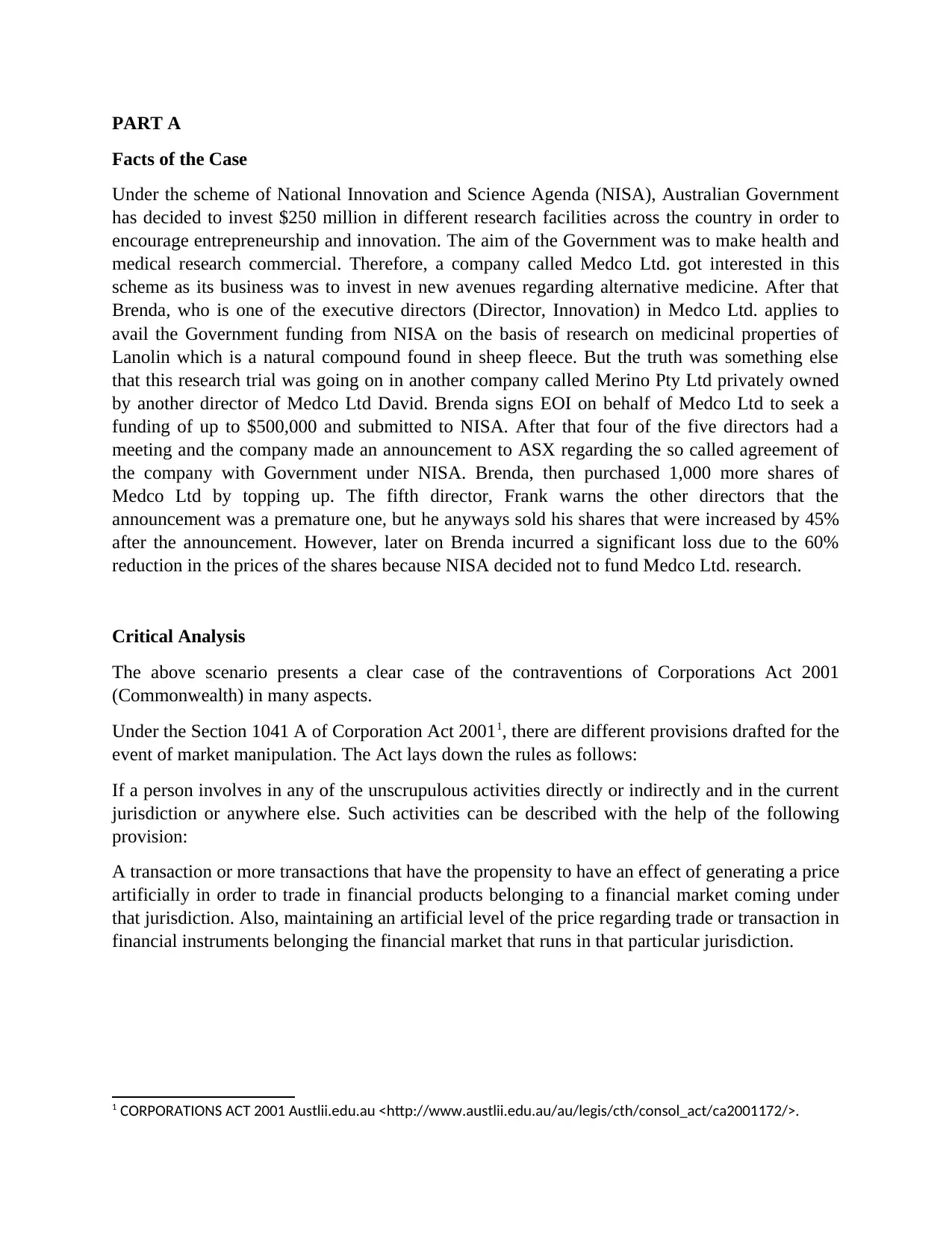
PART A
Facts of the Case
Under the scheme of National Innovation and Science Agenda (NISA), Australian Government
has decided to invest $250 million in different research facilities across the country in order to
encourage entrepreneurship and innovation. The aim of the Government was to make health and
medical research commercial. Therefore, a company called Medco Ltd. got interested in this
scheme as its business was to invest in new avenues regarding alternative medicine. After that
Brenda, who is one of the executive directors (Director, Innovation) in Medco Ltd. applies to
avail the Government funding from NISA on the basis of research on medicinal properties of
Lanolin which is a natural compound found in sheep fleece. But the truth was something else
that this research trial was going on in another company called Merino Pty Ltd privately owned
by another director of Medco Ltd David. Brenda signs EOI on behalf of Medco Ltd to seek a
funding of up to $500,000 and submitted to NISA. After that four of the five directors had a
meeting and the company made an announcement to ASX regarding the so called agreement of
the company with Government under NISA. Brenda, then purchased 1,000 more shares of
Medco Ltd by topping up. The fifth director, Frank warns the other directors that the
announcement was a premature one, but he anyways sold his shares that were increased by 45%
after the announcement. However, later on Brenda incurred a significant loss due to the 60%
reduction in the prices of the shares because NISA decided not to fund Medco Ltd. research.
Critical Analysis
The above scenario presents a clear case of the contraventions of Corporations Act 2001
(Commonwealth) in many aspects.
Under the Section 1041 A of Corporation Act 20011, there are different provisions drafted for the
event of market manipulation. The Act lays down the rules as follows:
If a person involves in any of the unscrupulous activities directly or indirectly and in the current
jurisdiction or anywhere else. Such activities can be described with the help of the following
provision:
A transaction or more transactions that have the propensity to have an effect of generating a price
artificially in order to trade in financial products belonging to a financial market coming under
that jurisdiction. Also, maintaining an artificial level of the price regarding trade or transaction in
financial instruments belonging the financial market that runs in that particular jurisdiction.
1 CORPORATIONS ACT 2001 Austlii.edu.au <http://www.austlii.edu.au/au/legis/cth/consol_act/ca2001172/>.
Facts of the Case
Under the scheme of National Innovation and Science Agenda (NISA), Australian Government
has decided to invest $250 million in different research facilities across the country in order to
encourage entrepreneurship and innovation. The aim of the Government was to make health and
medical research commercial. Therefore, a company called Medco Ltd. got interested in this
scheme as its business was to invest in new avenues regarding alternative medicine. After that
Brenda, who is one of the executive directors (Director, Innovation) in Medco Ltd. applies to
avail the Government funding from NISA on the basis of research on medicinal properties of
Lanolin which is a natural compound found in sheep fleece. But the truth was something else
that this research trial was going on in another company called Merino Pty Ltd privately owned
by another director of Medco Ltd David. Brenda signs EOI on behalf of Medco Ltd to seek a
funding of up to $500,000 and submitted to NISA. After that four of the five directors had a
meeting and the company made an announcement to ASX regarding the so called agreement of
the company with Government under NISA. Brenda, then purchased 1,000 more shares of
Medco Ltd by topping up. The fifth director, Frank warns the other directors that the
announcement was a premature one, but he anyways sold his shares that were increased by 45%
after the announcement. However, later on Brenda incurred a significant loss due to the 60%
reduction in the prices of the shares because NISA decided not to fund Medco Ltd. research.
Critical Analysis
The above scenario presents a clear case of the contraventions of Corporations Act 2001
(Commonwealth) in many aspects.
Under the Section 1041 A of Corporation Act 20011, there are different provisions drafted for the
event of market manipulation. The Act lays down the rules as follows:
If a person involves in any of the unscrupulous activities directly or indirectly and in the current
jurisdiction or anywhere else. Such activities can be described with the help of the following
provision:
A transaction or more transactions that have the propensity to have an effect of generating a price
artificially in order to trade in financial products belonging to a financial market coming under
that jurisdiction. Also, maintaining an artificial level of the price regarding trade or transaction in
financial instruments belonging the financial market that runs in that particular jurisdiction.
1 CORPORATIONS ACT 2001 Austlii.edu.au <http://www.austlii.edu.au/au/legis/cth/consol_act/ca2001172/>.
Paraphrase This Document
Need a fresh take? Get an instant paraphrase of this document with our AI Paraphraser
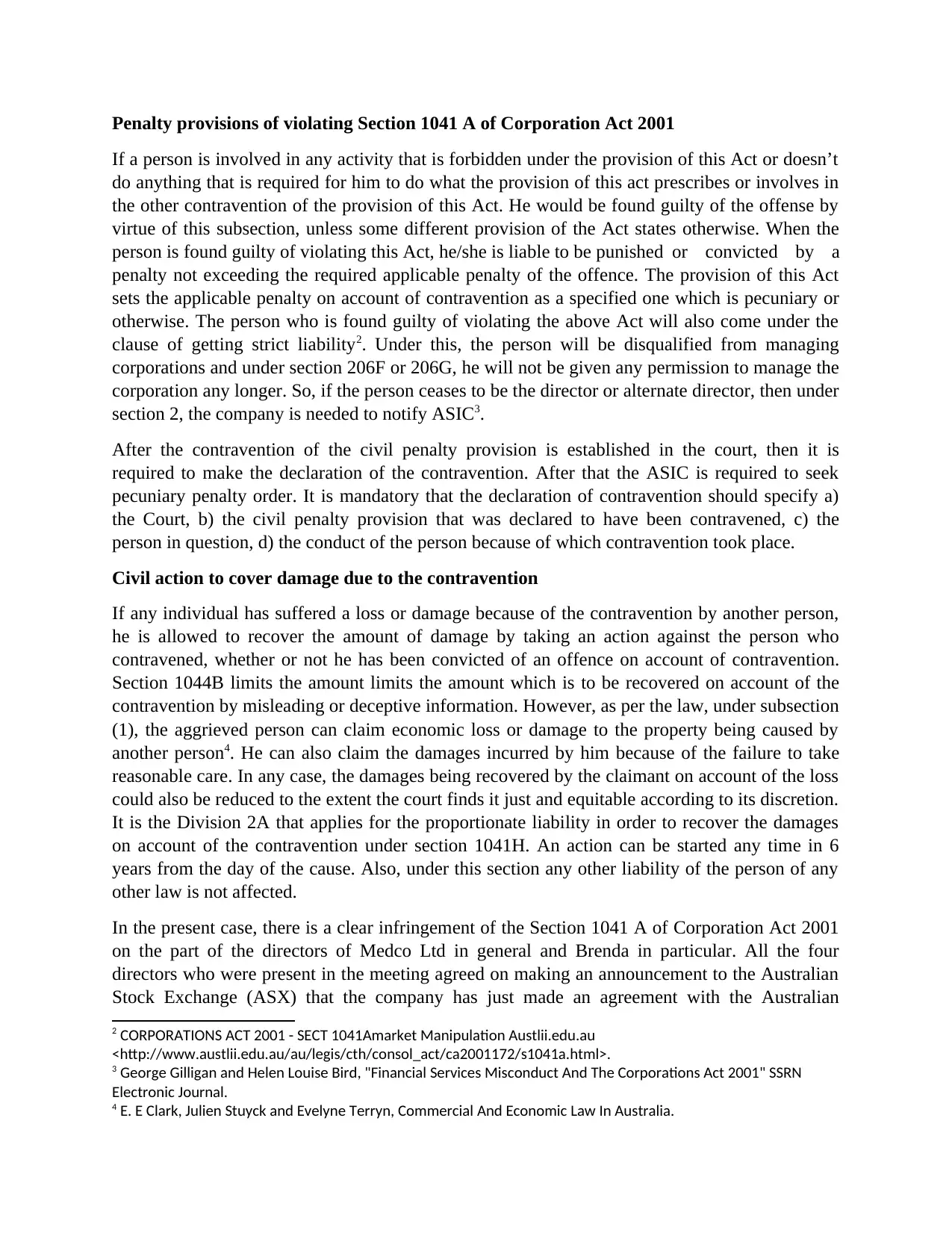
Penalty provisions of violating Section 1041 A of Corporation Act 2001
If a person is involved in any activity that is forbidden under the provision of this Act or doesn’t
do anything that is required for him to do what the provision of this act prescribes or involves in
the other contravention of the provision of this Act. He would be found guilty of the offense by
virtue of this subsection, unless some different provision of the Act states otherwise. When the
person is found guilty of violating this Act, he/she is liable to be punished or convicted by a
penalty not exceeding the required applicable penalty of the offence. The provision of this Act
sets the applicable penalty on account of contravention as a specified one which is pecuniary or
otherwise. The person who is found guilty of violating the above Act will also come under the
clause of getting strict liability2. Under this, the person will be disqualified from managing
corporations and under section 206F or 206G, he will not be given any permission to manage the
corporation any longer. So, if the person ceases to be the director or alternate director, then under
section 2, the company is needed to notify ASIC3.
After the contravention of the civil penalty provision is established in the court, then it is
required to make the declaration of the contravention. After that the ASIC is required to seek
pecuniary penalty order. It is mandatory that the declaration of contravention should specify a)
the Court, b) the civil penalty provision that was declared to have been contravened, c) the
person in question, d) the conduct of the person because of which contravention took place.
Civil action to cover damage due to the contravention
If any individual has suffered a loss or damage because of the contravention by another person,
he is allowed to recover the amount of damage by taking an action against the person who
contravened, whether or not he has been convicted of an offence on account of contravention.
Section 1044B limits the amount limits the amount which is to be recovered on account of the
contravention by misleading or deceptive information. However, as per the law, under subsection
(1), the aggrieved person can claim economic loss or damage to the property being caused by
another person4. He can also claim the damages incurred by him because of the failure to take
reasonable care. In any case, the damages being recovered by the claimant on account of the loss
could also be reduced to the extent the court finds it just and equitable according to its discretion.
It is the Division 2A that applies for the proportionate liability in order to recover the damages
on account of the contravention under section 1041H. An action can be started any time in 6
years from the day of the cause. Also, under this section any other liability of the person of any
other law is not affected.
In the present case, there is a clear infringement of the Section 1041 A of Corporation Act 2001
on the part of the directors of Medco Ltd in general and Brenda in particular. All the four
directors who were present in the meeting agreed on making an announcement to the Australian
Stock Exchange (ASX) that the company has just made an agreement with the Australian
2 CORPORATIONS ACT 2001 - SECT 1041Amarket Manipulation Austlii.edu.au
<http://www.austlii.edu.au/au/legis/cth/consol_act/ca2001172/s1041a.html>.
3 George Gilligan and Helen Louise Bird, "Financial Services Misconduct And The Corporations Act 2001" SSRN
Electronic Journal.
4 E. E Clark, Julien Stuyck and Evelyne Terryn, Commercial And Economic Law In Australia.
If a person is involved in any activity that is forbidden under the provision of this Act or doesn’t
do anything that is required for him to do what the provision of this act prescribes or involves in
the other contravention of the provision of this Act. He would be found guilty of the offense by
virtue of this subsection, unless some different provision of the Act states otherwise. When the
person is found guilty of violating this Act, he/she is liable to be punished or convicted by a
penalty not exceeding the required applicable penalty of the offence. The provision of this Act
sets the applicable penalty on account of contravention as a specified one which is pecuniary or
otherwise. The person who is found guilty of violating the above Act will also come under the
clause of getting strict liability2. Under this, the person will be disqualified from managing
corporations and under section 206F or 206G, he will not be given any permission to manage the
corporation any longer. So, if the person ceases to be the director or alternate director, then under
section 2, the company is needed to notify ASIC3.
After the contravention of the civil penalty provision is established in the court, then it is
required to make the declaration of the contravention. After that the ASIC is required to seek
pecuniary penalty order. It is mandatory that the declaration of contravention should specify a)
the Court, b) the civil penalty provision that was declared to have been contravened, c) the
person in question, d) the conduct of the person because of which contravention took place.
Civil action to cover damage due to the contravention
If any individual has suffered a loss or damage because of the contravention by another person,
he is allowed to recover the amount of damage by taking an action against the person who
contravened, whether or not he has been convicted of an offence on account of contravention.
Section 1044B limits the amount limits the amount which is to be recovered on account of the
contravention by misleading or deceptive information. However, as per the law, under subsection
(1), the aggrieved person can claim economic loss or damage to the property being caused by
another person4. He can also claim the damages incurred by him because of the failure to take
reasonable care. In any case, the damages being recovered by the claimant on account of the loss
could also be reduced to the extent the court finds it just and equitable according to its discretion.
It is the Division 2A that applies for the proportionate liability in order to recover the damages
on account of the contravention under section 1041H. An action can be started any time in 6
years from the day of the cause. Also, under this section any other liability of the person of any
other law is not affected.
In the present case, there is a clear infringement of the Section 1041 A of Corporation Act 2001
on the part of the directors of Medco Ltd in general and Brenda in particular. All the four
directors who were present in the meeting agreed on making an announcement to the Australian
Stock Exchange (ASX) that the company has just made an agreement with the Australian
2 CORPORATIONS ACT 2001 - SECT 1041Amarket Manipulation Austlii.edu.au
<http://www.austlii.edu.au/au/legis/cth/consol_act/ca2001172/s1041a.html>.
3 George Gilligan and Helen Louise Bird, "Financial Services Misconduct And The Corporations Act 2001" SSRN
Electronic Journal.
4 E. E Clark, Julien Stuyck and Evelyne Terryn, Commercial And Economic Law In Australia.
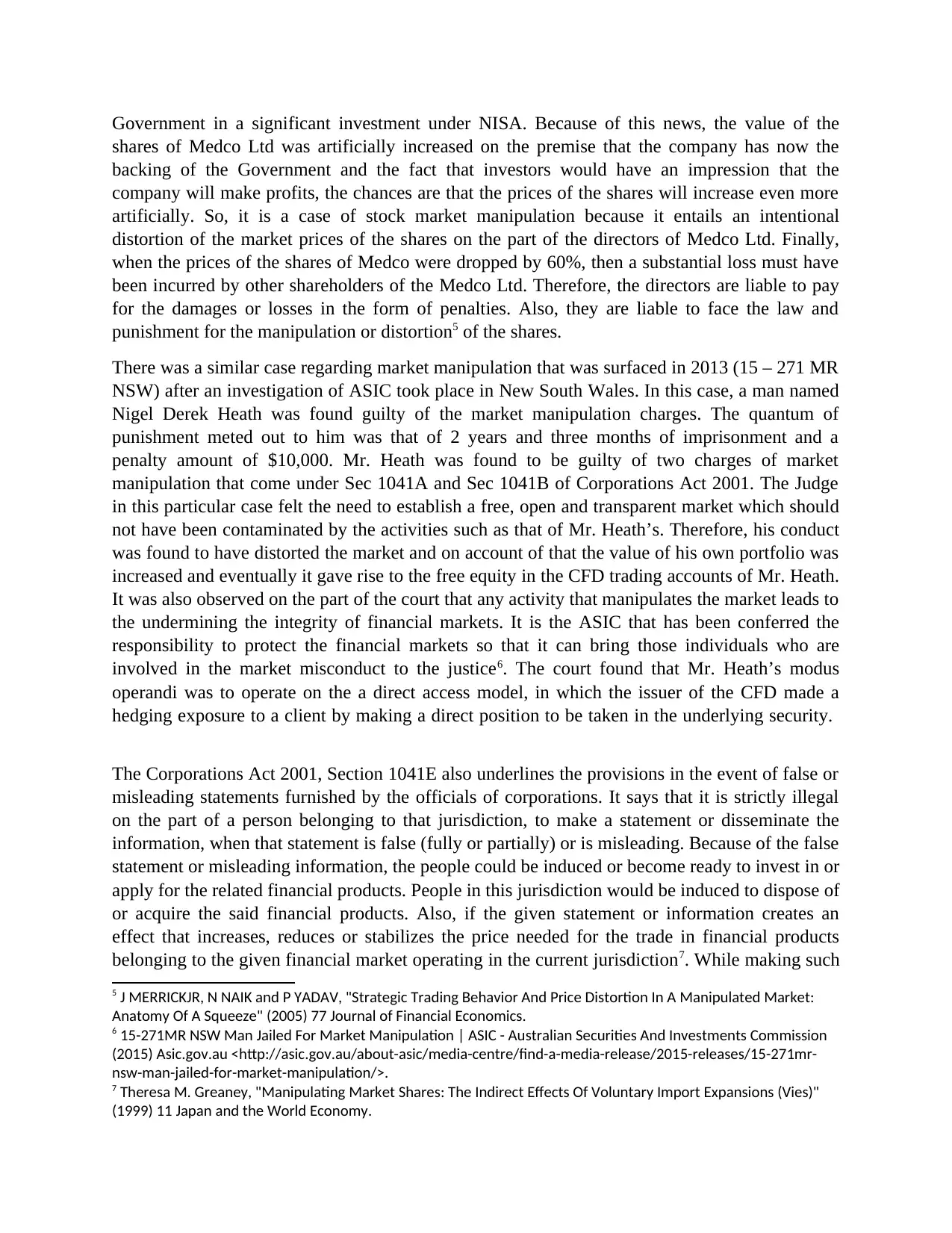
Government in a significant investment under NISA. Because of this news, the value of the
shares of Medco Ltd was artificially increased on the premise that the company has now the
backing of the Government and the fact that investors would have an impression that the
company will make profits, the chances are that the prices of the shares will increase even more
artificially. So, it is a case of stock market manipulation because it entails an intentional
distortion of the market prices of the shares on the part of the directors of Medco Ltd. Finally,
when the prices of the shares of Medco were dropped by 60%, then a substantial loss must have
been incurred by other shareholders of the Medco Ltd. Therefore, the directors are liable to pay
for the damages or losses in the form of penalties. Also, they are liable to face the law and
punishment for the manipulation or distortion5 of the shares.
There was a similar case regarding market manipulation that was surfaced in 2013 (15 – 271 MR
NSW) after an investigation of ASIC took place in New South Wales. In this case, a man named
Nigel Derek Heath was found guilty of the market manipulation charges. The quantum of
punishment meted out to him was that of 2 years and three months of imprisonment and a
penalty amount of $10,000. Mr. Heath was found to be guilty of two charges of market
manipulation that come under Sec 1041A and Sec 1041B of Corporations Act 2001. The Judge
in this particular case felt the need to establish a free, open and transparent market which should
not have been contaminated by the activities such as that of Mr. Heath’s. Therefore, his conduct
was found to have distorted the market and on account of that the value of his own portfolio was
increased and eventually it gave rise to the free equity in the CFD trading accounts of Mr. Heath.
It was also observed on the part of the court that any activity that manipulates the market leads to
the undermining the integrity of financial markets. It is the ASIC that has been conferred the
responsibility to protect the financial markets so that it can bring those individuals who are
involved in the market misconduct to the justice6. The court found that Mr. Heath’s modus
operandi was to operate on the a direct access model, in which the issuer of the CFD made a
hedging exposure to a client by making a direct position to be taken in the underlying security.
The Corporations Act 2001, Section 1041E also underlines the provisions in the event of false or
misleading statements furnished by the officials of corporations. It says that it is strictly illegal
on the part of a person belonging to that jurisdiction, to make a statement or disseminate the
information, when that statement is false (fully or partially) or is misleading. Because of the false
statement or misleading information, the people could be induced or become ready to invest in or
apply for the related financial products. People in this jurisdiction would be induced to dispose of
or acquire the said financial products. Also, if the given statement or information creates an
effect that increases, reduces or stabilizes the price needed for the trade in financial products
belonging to the given financial market operating in the current jurisdiction7. While making such
5 J MERRICKJR, N NAIK and P YADAV, "Strategic Trading Behavior And Price Distortion In A Manipulated Market:
Anatomy Of A Squeeze" (2005) 77 Journal of Financial Economics.
6 15-271MR NSW Man Jailed For Market Manipulation | ASIC - Australian Securities And Investments Commission
(2015) Asic.gov.au <http://asic.gov.au/about-asic/media-centre/find-a-media-release/2015-releases/15-271mr-
nsw-man-jailed-for-market-manipulation/>.
7 Theresa M. Greaney, "Manipulating Market Shares: The Indirect Effects Of Voluntary Import Expansions (Vies)"
(1999) 11 Japan and the World Economy.
shares of Medco Ltd was artificially increased on the premise that the company has now the
backing of the Government and the fact that investors would have an impression that the
company will make profits, the chances are that the prices of the shares will increase even more
artificially. So, it is a case of stock market manipulation because it entails an intentional
distortion of the market prices of the shares on the part of the directors of Medco Ltd. Finally,
when the prices of the shares of Medco were dropped by 60%, then a substantial loss must have
been incurred by other shareholders of the Medco Ltd. Therefore, the directors are liable to pay
for the damages or losses in the form of penalties. Also, they are liable to face the law and
punishment for the manipulation or distortion5 of the shares.
There was a similar case regarding market manipulation that was surfaced in 2013 (15 – 271 MR
NSW) after an investigation of ASIC took place in New South Wales. In this case, a man named
Nigel Derek Heath was found guilty of the market manipulation charges. The quantum of
punishment meted out to him was that of 2 years and three months of imprisonment and a
penalty amount of $10,000. Mr. Heath was found to be guilty of two charges of market
manipulation that come under Sec 1041A and Sec 1041B of Corporations Act 2001. The Judge
in this particular case felt the need to establish a free, open and transparent market which should
not have been contaminated by the activities such as that of Mr. Heath’s. Therefore, his conduct
was found to have distorted the market and on account of that the value of his own portfolio was
increased and eventually it gave rise to the free equity in the CFD trading accounts of Mr. Heath.
It was also observed on the part of the court that any activity that manipulates the market leads to
the undermining the integrity of financial markets. It is the ASIC that has been conferred the
responsibility to protect the financial markets so that it can bring those individuals who are
involved in the market misconduct to the justice6. The court found that Mr. Heath’s modus
operandi was to operate on the a direct access model, in which the issuer of the CFD made a
hedging exposure to a client by making a direct position to be taken in the underlying security.
The Corporations Act 2001, Section 1041E also underlines the provisions in the event of false or
misleading statements furnished by the officials of corporations. It says that it is strictly illegal
on the part of a person belonging to that jurisdiction, to make a statement or disseminate the
information, when that statement is false (fully or partially) or is misleading. Because of the false
statement or misleading information, the people could be induced or become ready to invest in or
apply for the related financial products. People in this jurisdiction would be induced to dispose of
or acquire the said financial products. Also, if the given statement or information creates an
effect that increases, reduces or stabilizes the price needed for the trade in financial products
belonging to the given financial market operating in the current jurisdiction7. While making such
5 J MERRICKJR, N NAIK and P YADAV, "Strategic Trading Behavior And Price Distortion In A Manipulated Market:
Anatomy Of A Squeeze" (2005) 77 Journal of Financial Economics.
6 15-271MR NSW Man Jailed For Market Manipulation | ASIC - Australian Securities And Investments Commission
(2015) Asic.gov.au <http://asic.gov.au/about-asic/media-centre/find-a-media-release/2015-releases/15-271mr-
nsw-man-jailed-for-market-manipulation/>.
7 Theresa M. Greaney, "Manipulating Market Shares: The Indirect Effects Of Voluntary Import Expansions (Vies)"
(1999) 11 Japan and the World Economy.
⊘ This is a preview!⊘
Do you want full access?
Subscribe today to unlock all pages.

Trusted by 1+ million students worldwide
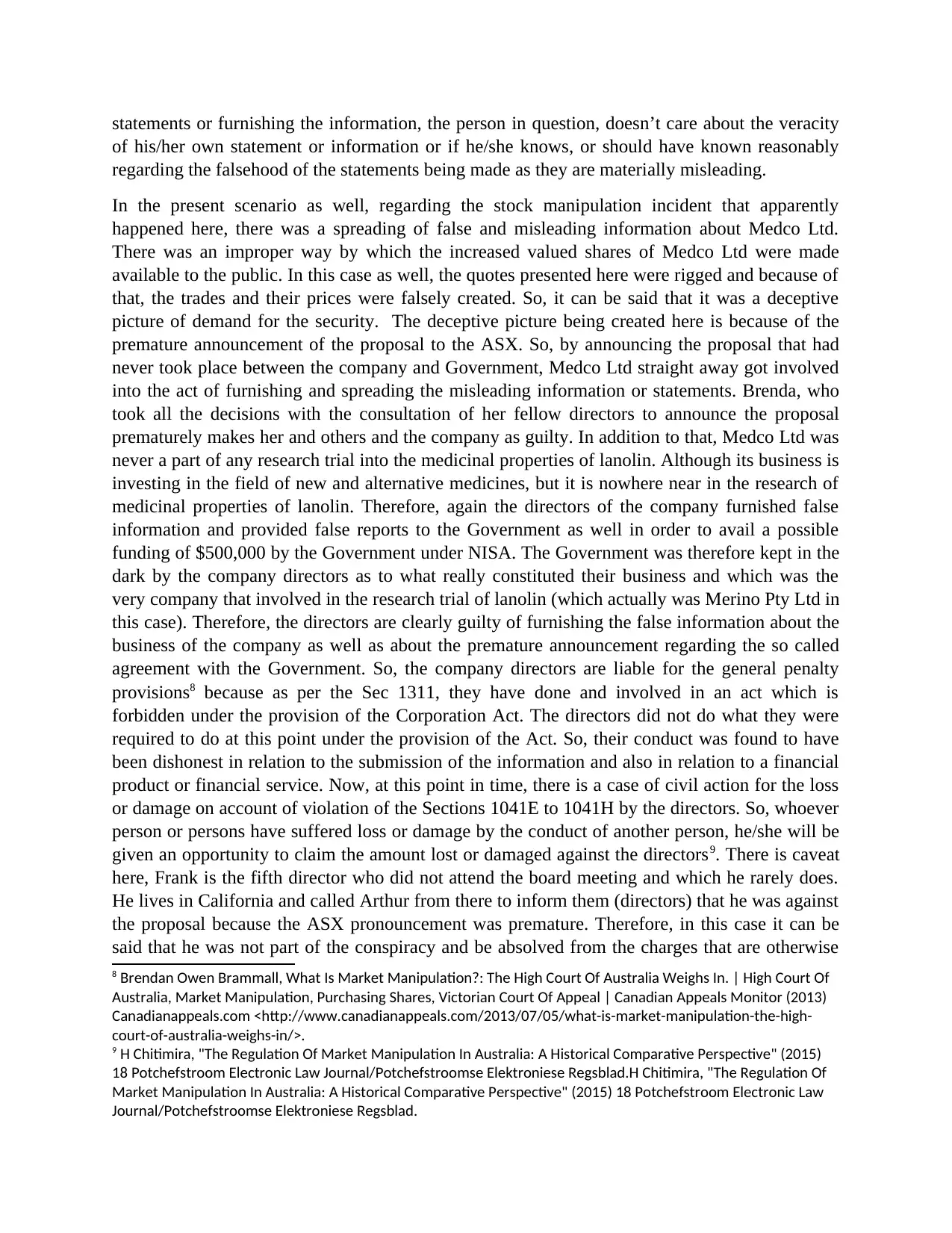
statements or furnishing the information, the person in question, doesn’t care about the veracity
of his/her own statement or information or if he/she knows, or should have known reasonably
regarding the falsehood of the statements being made as they are materially misleading.
In the present scenario as well, regarding the stock manipulation incident that apparently
happened here, there was a spreading of false and misleading information about Medco Ltd.
There was an improper way by which the increased valued shares of Medco Ltd were made
available to the public. In this case as well, the quotes presented here were rigged and because of
that, the trades and their prices were falsely created. So, it can be said that it was a deceptive
picture of demand for the security. The deceptive picture being created here is because of the
premature announcement of the proposal to the ASX. So, by announcing the proposal that had
never took place between the company and Government, Medco Ltd straight away got involved
into the act of furnishing and spreading the misleading information or statements. Brenda, who
took all the decisions with the consultation of her fellow directors to announce the proposal
prematurely makes her and others and the company as guilty. In addition to that, Medco Ltd was
never a part of any research trial into the medicinal properties of lanolin. Although its business is
investing in the field of new and alternative medicines, but it is nowhere near in the research of
medicinal properties of lanolin. Therefore, again the directors of the company furnished false
information and provided false reports to the Government as well in order to avail a possible
funding of $500,000 by the Government under NISA. The Government was therefore kept in the
dark by the company directors as to what really constituted their business and which was the
very company that involved in the research trial of lanolin (which actually was Merino Pty Ltd in
this case). Therefore, the directors are clearly guilty of furnishing the false information about the
business of the company as well as about the premature announcement regarding the so called
agreement with the Government. So, the company directors are liable for the general penalty
provisions8 because as per the Sec 1311, they have done and involved in an act which is
forbidden under the provision of the Corporation Act. The directors did not do what they were
required to do at this point under the provision of the Act. So, their conduct was found to have
been dishonest in relation to the submission of the information and also in relation to a financial
product or financial service. Now, at this point in time, there is a case of civil action for the loss
or damage on account of violation of the Sections 1041E to 1041H by the directors. So, whoever
person or persons have suffered loss or damage by the conduct of another person, he/she will be
given an opportunity to claim the amount lost or damaged against the directors9. There is caveat
here, Frank is the fifth director who did not attend the board meeting and which he rarely does.
He lives in California and called Arthur from there to inform them (directors) that he was against
the proposal because the ASX pronouncement was premature. Therefore, in this case it can be
said that he was not part of the conspiracy and be absolved from the charges that are otherwise
8 Brendan Owen Brammall, What Is Market Manipulation?: The High Court Of Australia Weighs In. | High Court Of
Australia, Market Manipulation, Purchasing Shares, Victorian Court Of Appeal | Canadian Appeals Monitor (2013)
Canadianappeals.com <http://www.canadianappeals.com/2013/07/05/what-is-market-manipulation-the-high-
court-of-australia-weighs-in/>.
9 H Chitimira, "The Regulation Of Market Manipulation In Australia: A Historical Comparative Perspective" (2015)
18 Potchefstroom Electronic Law Journal/Potchefstroomse Elektroniese Regsblad.H Chitimira, "The Regulation Of
Market Manipulation In Australia: A Historical Comparative Perspective" (2015) 18 Potchefstroom Electronic Law
Journal/Potchefstroomse Elektroniese Regsblad.
of his/her own statement or information or if he/she knows, or should have known reasonably
regarding the falsehood of the statements being made as they are materially misleading.
In the present scenario as well, regarding the stock manipulation incident that apparently
happened here, there was a spreading of false and misleading information about Medco Ltd.
There was an improper way by which the increased valued shares of Medco Ltd were made
available to the public. In this case as well, the quotes presented here were rigged and because of
that, the trades and their prices were falsely created. So, it can be said that it was a deceptive
picture of demand for the security. The deceptive picture being created here is because of the
premature announcement of the proposal to the ASX. So, by announcing the proposal that had
never took place between the company and Government, Medco Ltd straight away got involved
into the act of furnishing and spreading the misleading information or statements. Brenda, who
took all the decisions with the consultation of her fellow directors to announce the proposal
prematurely makes her and others and the company as guilty. In addition to that, Medco Ltd was
never a part of any research trial into the medicinal properties of lanolin. Although its business is
investing in the field of new and alternative medicines, but it is nowhere near in the research of
medicinal properties of lanolin. Therefore, again the directors of the company furnished false
information and provided false reports to the Government as well in order to avail a possible
funding of $500,000 by the Government under NISA. The Government was therefore kept in the
dark by the company directors as to what really constituted their business and which was the
very company that involved in the research trial of lanolin (which actually was Merino Pty Ltd in
this case). Therefore, the directors are clearly guilty of furnishing the false information about the
business of the company as well as about the premature announcement regarding the so called
agreement with the Government. So, the company directors are liable for the general penalty
provisions8 because as per the Sec 1311, they have done and involved in an act which is
forbidden under the provision of the Corporation Act. The directors did not do what they were
required to do at this point under the provision of the Act. So, their conduct was found to have
been dishonest in relation to the submission of the information and also in relation to a financial
product or financial service. Now, at this point in time, there is a case of civil action for the loss
or damage on account of violation of the Sections 1041E to 1041H by the directors. So, whoever
person or persons have suffered loss or damage by the conduct of another person, he/she will be
given an opportunity to claim the amount lost or damaged against the directors9. There is caveat
here, Frank is the fifth director who did not attend the board meeting and which he rarely does.
He lives in California and called Arthur from there to inform them (directors) that he was against
the proposal because the ASX pronouncement was premature. Therefore, in this case it can be
said that he was not part of the conspiracy and be absolved from the charges that are otherwise
8 Brendan Owen Brammall, What Is Market Manipulation?: The High Court Of Australia Weighs In. | High Court Of
Australia, Market Manipulation, Purchasing Shares, Victorian Court Of Appeal | Canadian Appeals Monitor (2013)
Canadianappeals.com <http://www.canadianappeals.com/2013/07/05/what-is-market-manipulation-the-high-
court-of-australia-weighs-in/>.
9 H Chitimira, "The Regulation Of Market Manipulation In Australia: A Historical Comparative Perspective" (2015)
18 Potchefstroom Electronic Law Journal/Potchefstroomse Elektroniese Regsblad.H Chitimira, "The Regulation Of
Market Manipulation In Australia: A Historical Comparative Perspective" (2015) 18 Potchefstroom Electronic Law
Journal/Potchefstroomse Elektroniese Regsblad.
Paraphrase This Document
Need a fresh take? Get an instant paraphrase of this document with our AI Paraphraser
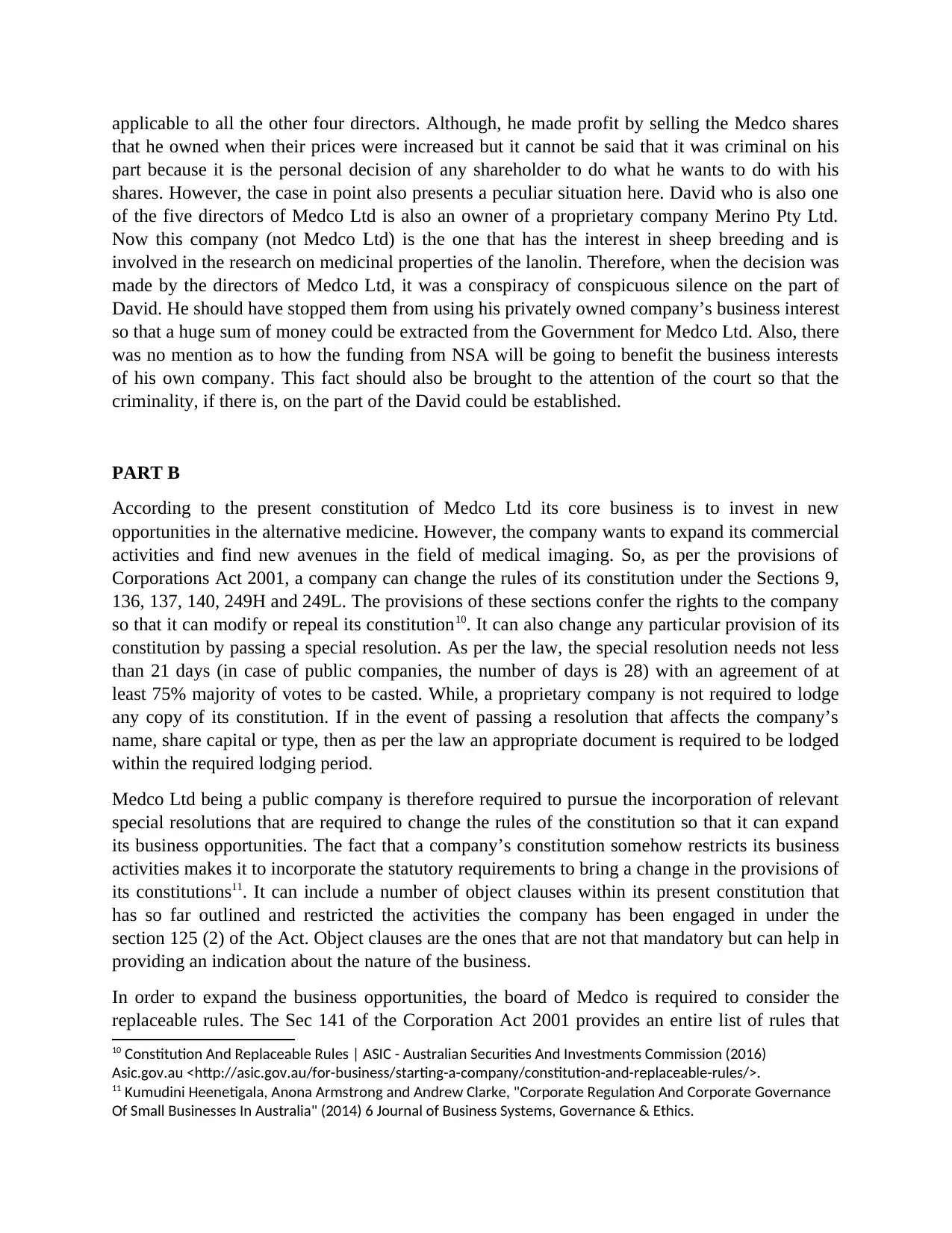
applicable to all the other four directors. Although, he made profit by selling the Medco shares
that he owned when their prices were increased but it cannot be said that it was criminal on his
part because it is the personal decision of any shareholder to do what he wants to do with his
shares. However, the case in point also presents a peculiar situation here. David who is also one
of the five directors of Medco Ltd is also an owner of a proprietary company Merino Pty Ltd.
Now this company (not Medco Ltd) is the one that has the interest in sheep breeding and is
involved in the research on medicinal properties of the lanolin. Therefore, when the decision was
made by the directors of Medco Ltd, it was a conspiracy of conspicuous silence on the part of
David. He should have stopped them from using his privately owned company’s business interest
so that a huge sum of money could be extracted from the Government for Medco Ltd. Also, there
was no mention as to how the funding from NSA will be going to benefit the business interests
of his own company. This fact should also be brought to the attention of the court so that the
criminality, if there is, on the part of the David could be established.
PART B
According to the present constitution of Medco Ltd its core business is to invest in new
opportunities in the alternative medicine. However, the company wants to expand its commercial
activities and find new avenues in the field of medical imaging. So, as per the provisions of
Corporations Act 2001, a company can change the rules of its constitution under the Sections 9,
136, 137, 140, 249H and 249L. The provisions of these sections confer the rights to the company
so that it can modify or repeal its constitution10. It can also change any particular provision of its
constitution by passing a special resolution. As per the law, the special resolution needs not less
than 21 days (in case of public companies, the number of days is 28) with an agreement of at
least 75% majority of votes to be casted. While, a proprietary company is not required to lodge
any copy of its constitution. If in the event of passing a resolution that affects the company’s
name, share capital or type, then as per the law an appropriate document is required to be lodged
within the required lodging period.
Medco Ltd being a public company is therefore required to pursue the incorporation of relevant
special resolutions that are required to change the rules of the constitution so that it can expand
its business opportunities. The fact that a company’s constitution somehow restricts its business
activities makes it to incorporate the statutory requirements to bring a change in the provisions of
its constitutions11. It can include a number of object clauses within its present constitution that
has so far outlined and restricted the activities the company has been engaged in under the
section 125 (2) of the Act. Object clauses are the ones that are not that mandatory but can help in
providing an indication about the nature of the business.
In order to expand the business opportunities, the board of Medco is required to consider the
replaceable rules. The Sec 141 of the Corporation Act 2001 provides an entire list of rules that
10 Constitution And Replaceable Rules | ASIC - Australian Securities And Investments Commission (2016)
Asic.gov.au <http://asic.gov.au/for-business/starting-a-company/constitution-and-replaceable-rules/>.
11 Kumudini Heenetigala, Anona Armstrong and Andrew Clarke, "Corporate Regulation And Corporate Governance
Of Small Businesses In Australia" (2014) 6 Journal of Business Systems, Governance & Ethics.
that he owned when their prices were increased but it cannot be said that it was criminal on his
part because it is the personal decision of any shareholder to do what he wants to do with his
shares. However, the case in point also presents a peculiar situation here. David who is also one
of the five directors of Medco Ltd is also an owner of a proprietary company Merino Pty Ltd.
Now this company (not Medco Ltd) is the one that has the interest in sheep breeding and is
involved in the research on medicinal properties of the lanolin. Therefore, when the decision was
made by the directors of Medco Ltd, it was a conspiracy of conspicuous silence on the part of
David. He should have stopped them from using his privately owned company’s business interest
so that a huge sum of money could be extracted from the Government for Medco Ltd. Also, there
was no mention as to how the funding from NSA will be going to benefit the business interests
of his own company. This fact should also be brought to the attention of the court so that the
criminality, if there is, on the part of the David could be established.
PART B
According to the present constitution of Medco Ltd its core business is to invest in new
opportunities in the alternative medicine. However, the company wants to expand its commercial
activities and find new avenues in the field of medical imaging. So, as per the provisions of
Corporations Act 2001, a company can change the rules of its constitution under the Sections 9,
136, 137, 140, 249H and 249L. The provisions of these sections confer the rights to the company
so that it can modify or repeal its constitution10. It can also change any particular provision of its
constitution by passing a special resolution. As per the law, the special resolution needs not less
than 21 days (in case of public companies, the number of days is 28) with an agreement of at
least 75% majority of votes to be casted. While, a proprietary company is not required to lodge
any copy of its constitution. If in the event of passing a resolution that affects the company’s
name, share capital or type, then as per the law an appropriate document is required to be lodged
within the required lodging period.
Medco Ltd being a public company is therefore required to pursue the incorporation of relevant
special resolutions that are required to change the rules of the constitution so that it can expand
its business opportunities. The fact that a company’s constitution somehow restricts its business
activities makes it to incorporate the statutory requirements to bring a change in the provisions of
its constitutions11. It can include a number of object clauses within its present constitution that
has so far outlined and restricted the activities the company has been engaged in under the
section 125 (2) of the Act. Object clauses are the ones that are not that mandatory but can help in
providing an indication about the nature of the business.
In order to expand the business opportunities, the board of Medco is required to consider the
replaceable rules. The Sec 141 of the Corporation Act 2001 provides an entire list of rules that
10 Constitution And Replaceable Rules | ASIC - Australian Securities And Investments Commission (2016)
Asic.gov.au <http://asic.gov.au/for-business/starting-a-company/constitution-and-replaceable-rules/>.
11 Kumudini Heenetigala, Anona Armstrong and Andrew Clarke, "Corporate Regulation And Corporate Governance
Of Small Businesses In Australia" (2014) 6 Journal of Business Systems, Governance & Ethics.
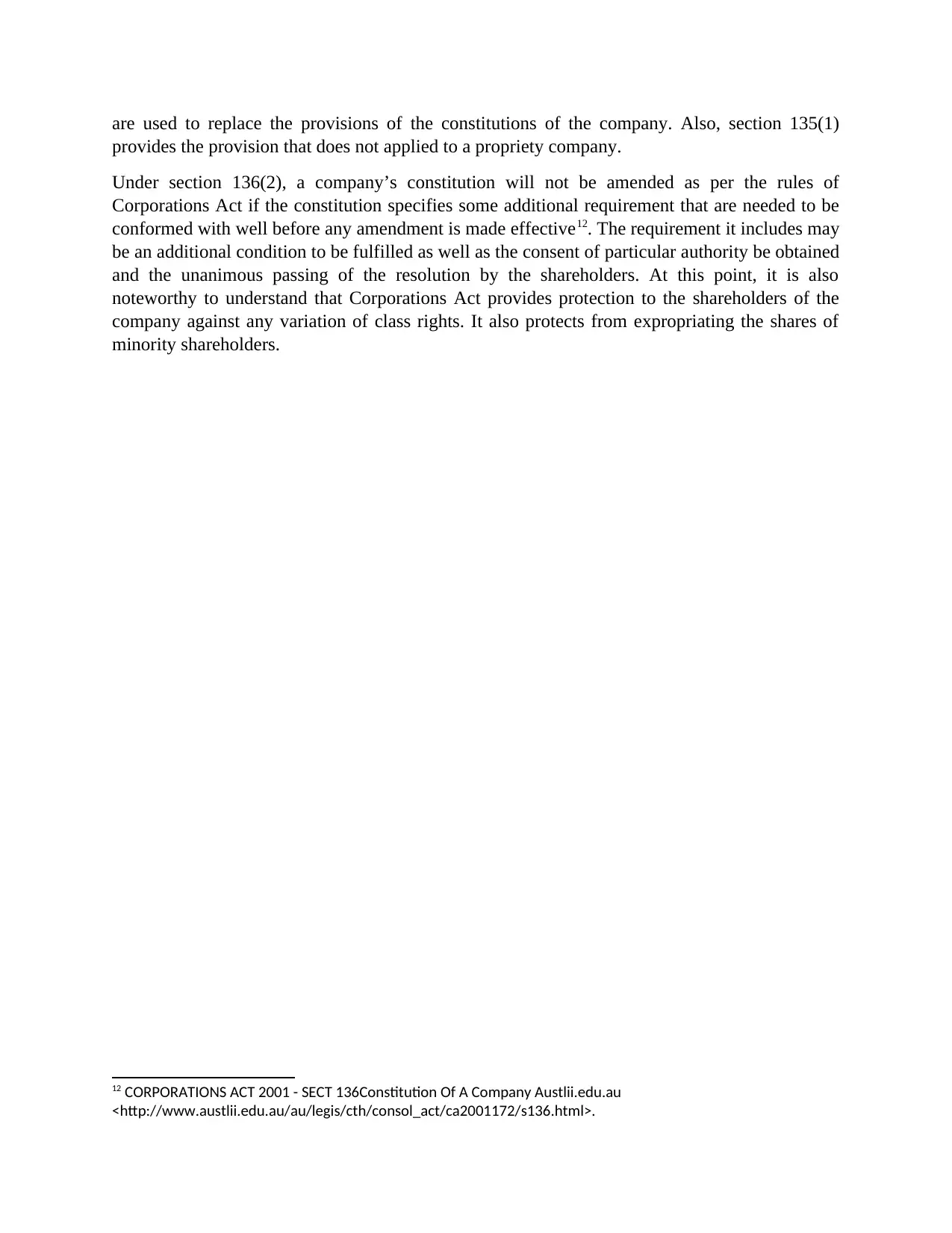
are used to replace the provisions of the constitutions of the company. Also, section 135(1)
provides the provision that does not applied to a propriety company.
Under section 136(2), a company’s constitution will not be amended as per the rules of
Corporations Act if the constitution specifies some additional requirement that are needed to be
conformed with well before any amendment is made effective12. The requirement it includes may
be an additional condition to be fulfilled as well as the consent of particular authority be obtained
and the unanimous passing of the resolution by the shareholders. At this point, it is also
noteworthy to understand that Corporations Act provides protection to the shareholders of the
company against any variation of class rights. It also protects from expropriating the shares of
minority shareholders.
12 CORPORATIONS ACT 2001 - SECT 136Constitution Of A Company Austlii.edu.au
<http://www.austlii.edu.au/au/legis/cth/consol_act/ca2001172/s136.html>.
provides the provision that does not applied to a propriety company.
Under section 136(2), a company’s constitution will not be amended as per the rules of
Corporations Act if the constitution specifies some additional requirement that are needed to be
conformed with well before any amendment is made effective12. The requirement it includes may
be an additional condition to be fulfilled as well as the consent of particular authority be obtained
and the unanimous passing of the resolution by the shareholders. At this point, it is also
noteworthy to understand that Corporations Act provides protection to the shareholders of the
company against any variation of class rights. It also protects from expropriating the shares of
minority shareholders.
12 CORPORATIONS ACT 2001 - SECT 136Constitution Of A Company Austlii.edu.au
<http://www.austlii.edu.au/au/legis/cth/consol_act/ca2001172/s136.html>.
⊘ This is a preview!⊘
Do you want full access?
Subscribe today to unlock all pages.

Trusted by 1+ million students worldwide
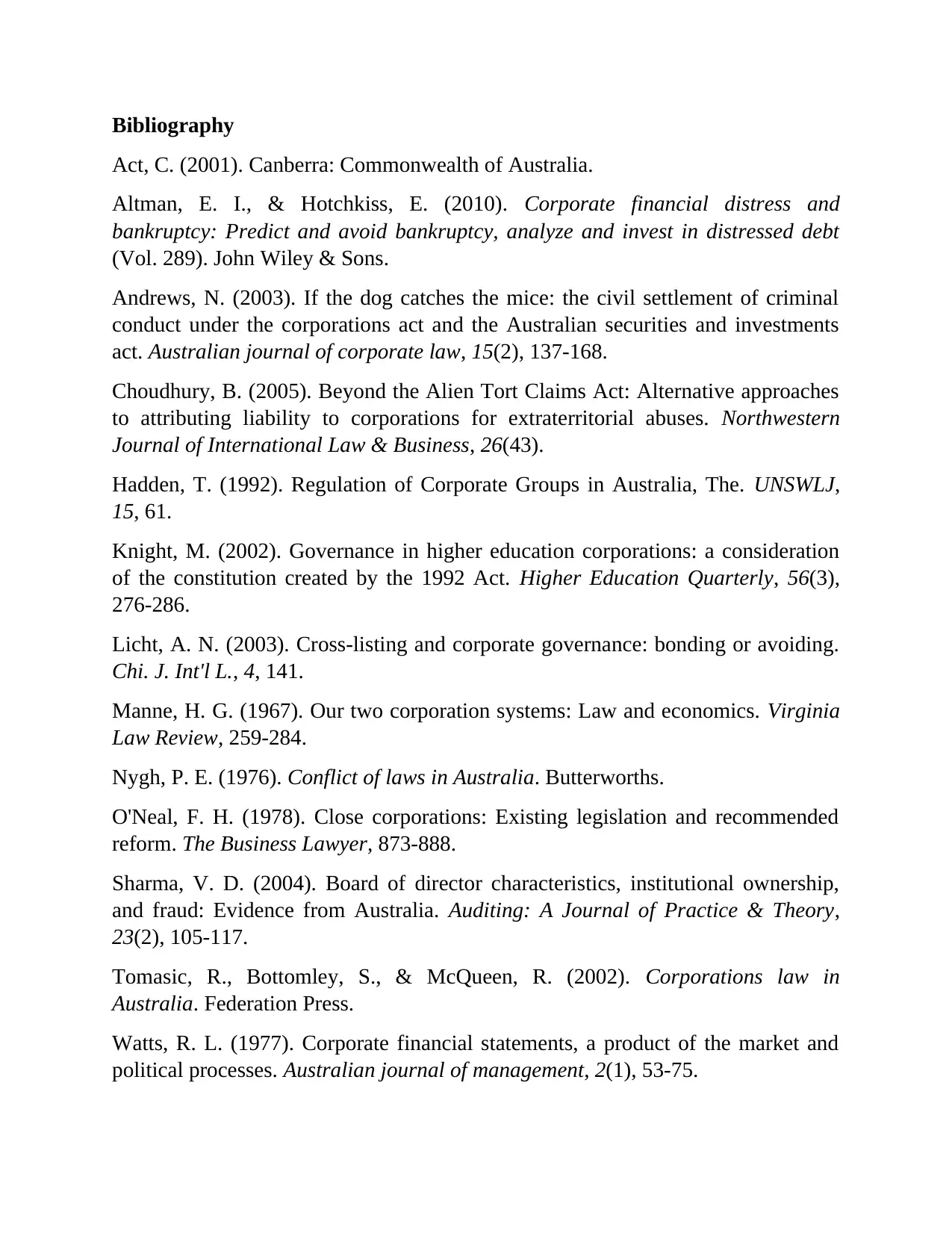
Bibliography
Act, C. (2001). Canberra: Commonwealth of Australia.
Altman, E. I., & Hotchkiss, E. (2010). Corporate financial distress and
bankruptcy: Predict and avoid bankruptcy, analyze and invest in distressed debt
(Vol. 289). John Wiley & Sons.
Andrews, N. (2003). If the dog catches the mice: the civil settlement of criminal
conduct under the corporations act and the Australian securities and investments
act. Australian journal of corporate law, 15(2), 137-168.
Choudhury, B. (2005). Beyond the Alien Tort Claims Act: Alternative approaches
to attributing liability to corporations for extraterritorial abuses. Northwestern
Journal of International Law & Business, 26(43).
Hadden, T. (1992). Regulation of Corporate Groups in Australia, The. UNSWLJ,
15, 61.
Knight, M. (2002). Governance in higher education corporations: a consideration
of the constitution created by the 1992 Act. Higher Education Quarterly, 56(3),
276-286.
Licht, A. N. (2003). Cross-listing and corporate governance: bonding or avoiding.
Chi. J. Int'l L., 4, 141.
Manne, H. G. (1967). Our two corporation systems: Law and economics. Virginia
Law Review, 259-284.
Nygh, P. E. (1976). Conflict of laws in Australia. Butterworths.
O'Neal, F. H. (1978). Close corporations: Existing legislation and recommended
reform. The Business Lawyer, 873-888.
Sharma, V. D. (2004). Board of director characteristics, institutional ownership,
and fraud: Evidence from Australia. Auditing: A Journal of Practice & Theory,
23(2), 105-117.
Tomasic, R., Bottomley, S., & McQueen, R. (2002). Corporations law in
Australia. Federation Press.
Watts, R. L. (1977). Corporate financial statements, a product of the market and
political processes. Australian journal of management, 2(1), 53-75.
Act, C. (2001). Canberra: Commonwealth of Australia.
Altman, E. I., & Hotchkiss, E. (2010). Corporate financial distress and
bankruptcy: Predict and avoid bankruptcy, analyze and invest in distressed debt
(Vol. 289). John Wiley & Sons.
Andrews, N. (2003). If the dog catches the mice: the civil settlement of criminal
conduct under the corporations act and the Australian securities and investments
act. Australian journal of corporate law, 15(2), 137-168.
Choudhury, B. (2005). Beyond the Alien Tort Claims Act: Alternative approaches
to attributing liability to corporations for extraterritorial abuses. Northwestern
Journal of International Law & Business, 26(43).
Hadden, T. (1992). Regulation of Corporate Groups in Australia, The. UNSWLJ,
15, 61.
Knight, M. (2002). Governance in higher education corporations: a consideration
of the constitution created by the 1992 Act. Higher Education Quarterly, 56(3),
276-286.
Licht, A. N. (2003). Cross-listing and corporate governance: bonding or avoiding.
Chi. J. Int'l L., 4, 141.
Manne, H. G. (1967). Our two corporation systems: Law and economics. Virginia
Law Review, 259-284.
Nygh, P. E. (1976). Conflict of laws in Australia. Butterworths.
O'Neal, F. H. (1978). Close corporations: Existing legislation and recommended
reform. The Business Lawyer, 873-888.
Sharma, V. D. (2004). Board of director characteristics, institutional ownership,
and fraud: Evidence from Australia. Auditing: A Journal of Practice & Theory,
23(2), 105-117.
Tomasic, R., Bottomley, S., & McQueen, R. (2002). Corporations law in
Australia. Federation Press.
Watts, R. L. (1977). Corporate financial statements, a product of the market and
political processes. Australian journal of management, 2(1), 53-75.
Paraphrase This Document
Need a fresh take? Get an instant paraphrase of this document with our AI Paraphraser
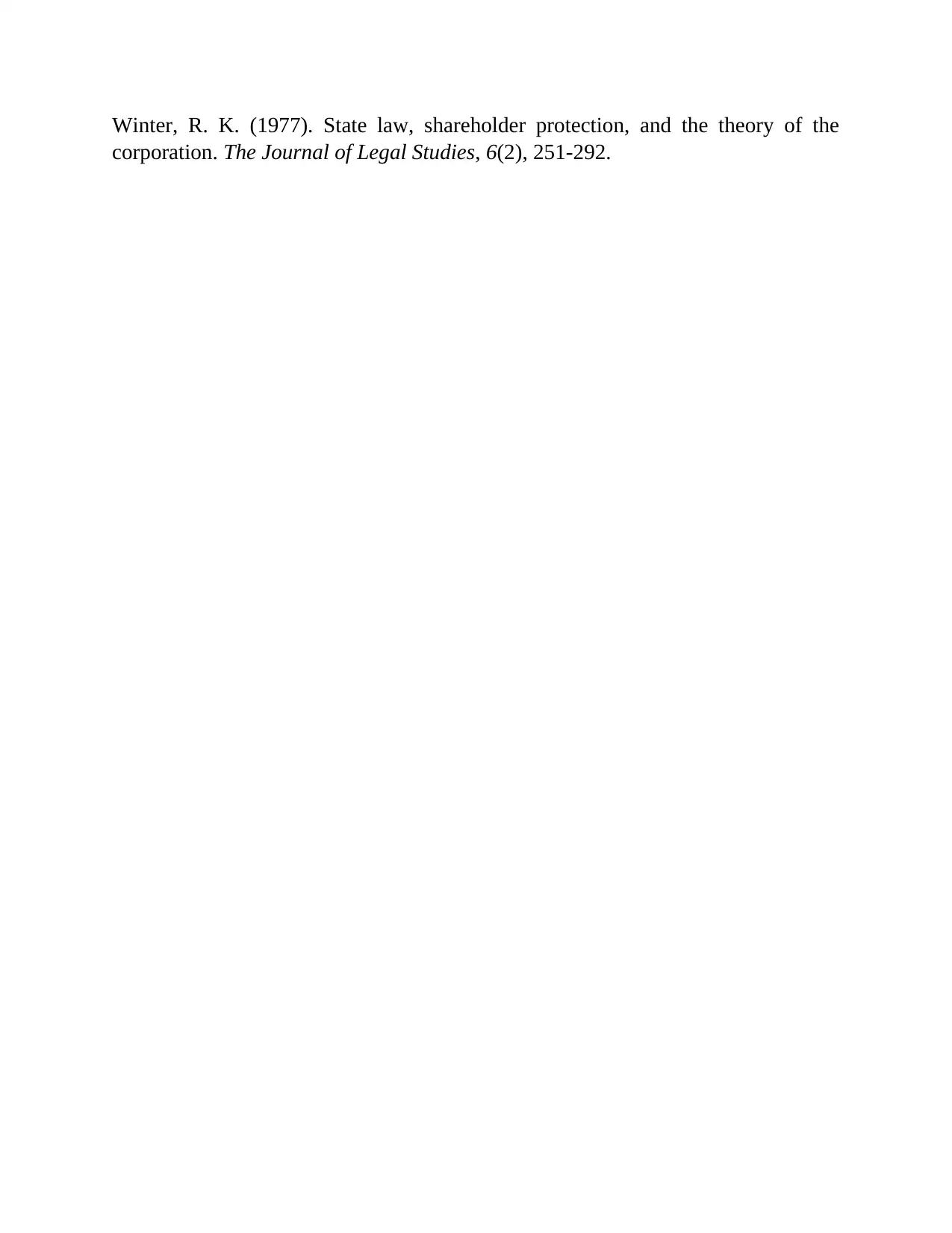
Winter, R. K. (1977). State law, shareholder protection, and the theory of the
corporation. The Journal of Legal Studies, 6(2), 251-292.
corporation. The Journal of Legal Studies, 6(2), 251-292.
1 out of 8
Your All-in-One AI-Powered Toolkit for Academic Success.
+13062052269
info@desklib.com
Available 24*7 on WhatsApp / Email
![[object Object]](/_next/static/media/star-bottom.7253800d.svg)
Unlock your academic potential
Copyright © 2020–2025 A2Z Services. All Rights Reserved. Developed and managed by ZUCOL.
